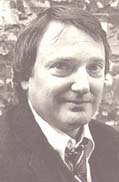|
amongst this pile of books by the bed
the bottom of a magazine sticks out, as it
has for some weeks now, announcing ‘Chuck Close’
— an exhibition — & consequently, if briefly, I think of him,
a career I know almost
nothing about: one portrait, that resembles
the IRA’s Gerry Adams, but which resembles
more, presumably, Close himself. Also by the bed
another’s portrait, someone I’ve met, almost
diaphanous — evanescent — in the photo: I met the poet it
depicts years after it was taken. It seems therefore magical & fictive, like a fable
about him —
a fable he has been cast in — relative to the solidity of the few facts
that, for me, constitute Close.
A more recent image of Chuck Close
has him in a wheelchair. He is painting, & it resembles
that same portrait, so I take it it’s him —
done in grids, pixellated in appearance, looming over artist, wheelchair, bed,
table-with-brushes — though (in greys) it could almost,
or easily , be a drawing. It
suggests some struggle, heroism . . . It
is something I hadn’t known about Chuck Close.
For seconds each night, regularly almost —
though subliminally until today — which , irritatingly, resembles
suddenly the day before it, in that again for some seconds this morning, in bed,
unwillingly I entertain my only two images of him —
they ‘pop up’: & I dwell on them — on him —
(or don’t) momentarily. It
is my memory’s almost empty file on Chuck Close — &, in bed,
it comes to me. Normally it wouldn’t, and thinking of Close
I think pretty immediately of Thomas Ruff, whose work his resembles —
the German photographer, in large format, of faces & streets. While I have almost
never thought about the American I have thought about Ruff — who almost
came to Australia, I think. Michel Snelling phoned to ask should we bring him.
Out of regret that I didn’t push harder I’ve attended to Ruff ever since. All of which
in no way resembles
my feelings for this other portrait — a poet whose work I love, so that it
is pure good faith, this relationship. The ‘‘cool’’ of the early Close
I found unimpressive, & ugly — in a fashionable way, whose fashionability I wasn’t
buying. Chuck’s by the bed
by accident, a name only. The poems’ place though, by the bed, is permanent. It
is the poet’s Selected, out of print. On it Towle resembles other pictures
I have seen of him,
though it is the most curious. He might almost have borrowed the coat he wears.
He will regret, amusedly, his hair. The guileless heroism of the smile,
the eyes, he will not regret. But the poems I keep close
 he might have wanted more for. Granted Close
he might have wanted more for. Granted Close
the pathos of the new works — though I have only experienced it via
magazine pages, one or two pictures . . .
Then, Minimalism & Pop ‘had had their day’
as things new & imperative. I didn’t find them
(or him), in 1974, inherently compelling. Not the way
I found about the same time, say, Tuckson, Robert Ryman. (This is the way
guilt maintains a close connection between me and a particular sub-set
of art works. As close
or closer than between me and works I’ve liked probably. I remember them
ruefully: a history of opinions (mine), via
mistakes I might have made.) Literalism was my big thing. Will the day
come when it is not? I’m not sure it still isn’t. Though the pictures
on the back of Towle’s books regard me quizzically as I say it — pictures
in which his face has altered from a kind of resolute simplicity, looking the way
David would paint Napoleon say, towards a more casually raffish, day-
at-the-office, pose: open collar, hair tousled, the close
New York weather (tho Larry Rivers’ artwork suggests a Via
dei Carrottieri, Via del Corso . . . a coffee shop or bar on one of them,
|
